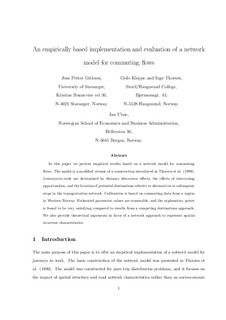| dc.contributor.author | Gitlesen, Jens Petter | |
| dc.contributor.author | Kleppe, Gisle | |
| dc.contributor.author | Thorsen, Inge | |
| dc.contributor.author | Ubøe, Jan | |
| dc.date.accessioned | 2006-07-11T10:21:45Z | |
| dc.date.available | 2006-07-11T10:21:45Z | |
| dc.date.issued | 2006 | |
| dc.identifier.issn | 1500-4066 | |
| dc.identifier.uri | http://hdl.handle.net/11250/163605 | |
| dc.description.abstract | In this paper we present empirical results based on a network model for commuting flows. The model is a modified version of a construction introduced in Thorsen et al. (1999). Journeys-to-work are determined by distance deterrence effects, the effects of intervening opportunities, and the location of potential destinations relative to alternatives at subsequent steps in the transportation network. Calibration is based on commuting data from a region in Western Norway. Estimated parameter values are reasonable, and the explanatory power is found to be very satisfying compared to results from a competing destinations approach. We also provide theoretical arguments in favor of a network approach to represent spatial structure characteristics. | en |
| dc.format.extent | 242827 bytes | |
| dc.format.mimetype | application/pdf | |
| dc.language.iso | eng | en |
| dc.publisher | Norwegian School of Economics and Business Administration. Department of Finance and Management Science | en |
| dc.relation.ispartofseries | Discussion paper | en |
| dc.relation.ispartofseries | 2006:4 | en |
| dc.title | An empirically based implementation and evaluation of a network model for commuting flows | en |
| dc.type | Working paper | en |
